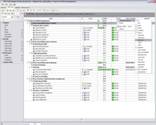 |
|
 |
VIP Task Manager |
 |
|
 |
VIP Task Manager |
|
Project portfolio management is used to select a portfolio of new product development projects to achieve the following goals:
Project portfolio management answers the question: What projects are correct, i.e. have the maximum value for the company. It allows to reach project goals without being beyond the project restrictions. There are four phases of project portfolio lifecycle: 1. Phase of portfolio project creation The main goal of this phase is to provide formation of projects pool which then potentially can be initiated and accepted to implementation. On the given phase gathering design initiatives and requirements without financial and other restrictions of the company are carried out. In different companies this phase can be organized differently depending on scale of the company and volume of design requirements. Basically, all it is reduced to the following steps:
After coordination and statement of the Business plan, project gets to the pool of projects which are potentially attractive to be implemented in project portfolio. 2. Phase of portfolio project selection The aim of this phase is a selection of project to portfolio in accordance with financial and other portfolio restrictions. From the pool of potential projects obtained in previous phase, new portfolio is created. On this phase typical process includes two steps that can be modified according to business specificity and organizational structure. The steps are:
|
||
|
3. Phase of portfolio project planning On this phase the following processes are carried out:
Specificity of the phase is that at planning of project portfolio, all shared resources (i.e. those resources which will be involved in multiple projects) should be considered and resource conflicts should be resolved beforehand. |
||
| 4. Phase of project implementation management On this phase the following problems are considered:
| ||
|
With VIP Task Manager the project manager can work closely together with team members and manage the whole project portfolio as well as any kind of a project, such as enterprise IT projects, service projects or research and development. After company management has launched a new product development, the project manager can set up the project structure. VIP Task Manager enables him to manage schedules, resources, assigned documents and materials, costs, and budgets. Team participants are notified via notifications when they need to accomplish their project-related tasks according to the overall workflow. Using VIP Task Manager they can report on task progress, and the actual dates, and other. All task changes are immediately updated so that the project manager can monitor the projects at any time. The outcome is efficient portfolio project management which provides significant value potential - each day saves money and brings products to the customer faster. |
||
 |
|
 |
VIP Task Manager |




 Play Demo
Play Demo
 Play Demo
Play Demo